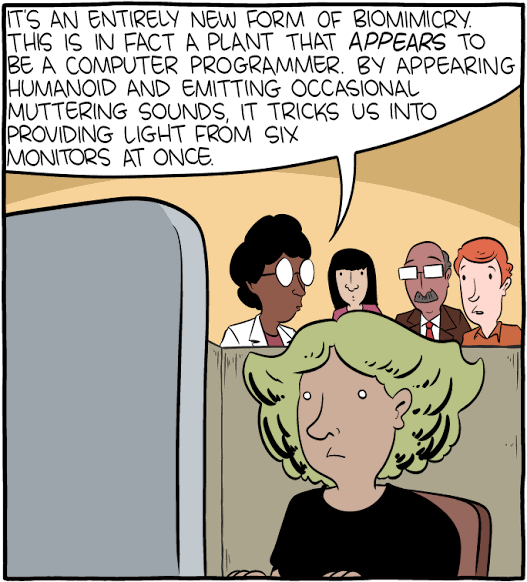One possibility could be wind-powered plants.
A tidally locked planet with a stable atmosphere must necessarily have powerful winds transporting heat from the day side to the night side. (Ocean currents can also contribute to the heat transport, but you're still going to have a significant temperature differential between the two sides, which is going to generate winds.) A plant growing near the terminator could supplement the meager sunlight available there by extracting energy from the wind, and once such a mechanism evolved to be sufficiently efficient, it could even allow those plants to grow without any sunlight at all.
What would such plants look like? I'd imagine a primitive (or simply convervative) form might look like a tree with leaves that flutter in the wind, just like they do on trees here on Earth. The differences would be at the cellular level, where the hypothetical wind-trees would have some way of converting mechanical oscillation into chemical energy — perhaps by using the alternating compression and decompression of their cells to drive an ion pump and create an ion concentration gradient across the cellular membrane, which they could then use to drive chemical reactions (like ATP synthesis in an Earth-like biochemistry).
All of this seems perfectly doable using little more than standard Earth biochemical building blocks. The fact that no plants on Earth have evolved to exploit this power source is probably due to the combination of insufficient selection pressure (there being few places on Earth with lots of wind and little sunlight) and simple lack of time for evolution to explore this particular corner of the fitness landscape.
Of course, once a plant on our hypothetical planet becomes fully wind-powered and fully loses its dependency on sunlight, there's likely to be lots of rapid morphological evolution and divergence as the descendants of these plants spread and adapt to their new niche. For one thing, these "plants" would most likely lose their photosynthetic capability entirely — it's complex, expensive to maintain and useless on the dark side. This in turn will free their leaf morphology to evolve to fully maximize wind capture efficiency, with no constraints on having to also collect sunlight.
So I'm imagining something like tall rigid masts rising up into the windstream, with pale white banners fluttering behind them like sails on a boat turning into the wind. Or perhaps the semi-rigid stems could themselves be the vibrating elements, like giant cat's whiskers standing upright and humming in the wind. Or perhaps some varieties could look like long streamers, anchored to a suitable terrain outcrop (or to another plant!) at one end, with the rest of the plant just freely fluttering in the wind behind it.
What I don't really expect to see would be rotors of any kind: while efficient at capturing wind energy, they'd necessitate the evolution of a freely rotating biological axle, something that evolution on Earth never seems to have managed. If such a mechanism did evolve, the rotating part would likely be fully composed of dead tissue — the rotors would grow while still attached to the main plant, then harden and detach so that they can start rotating. But I'd still find a purely vibrational ("fluttering") mechanism more likely.
Also, while I've been imagining all this evolution occurring on land, there's really no reason why it couldn't happen underwater as well. Actually, now I'm wondering why it apparently has never happened that way on Earth, given that there are surely lots of places underwater with plenty of currents but very little light. Perhaps it's just the difficulty of converting the existing photosynthetic machinery over to a new energy source, coupled with the fact that this source can really only be efficiently exploited by multicellular organisms (which tend to have longer generation times, and consequently slower evolution, than unicellular microbes) with advanced materials like cellulose to stiffen their structure (which, on evolutionary timescales, have only appeared relatively recently).

